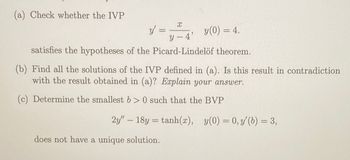(a) Check whether the IVP = y(0) = 4. -4' satisfies the hypotheses of the Picard-Lindelöf theorem. X Y (b) Find all the solutions of the IVP defined in (a). Is this result in contradiction with the result obtained in (a)? Explain your answer.
(a) Check whether the IVP = y(0) = 4. -4' satisfies the hypotheses of the Picard-Lindelöf theorem. X Y (b) Find all the solutions of the IVP defined in (a). Is this result in contradiction with the result obtained in (a)? Explain your answer.
Advanced Engineering Mathematics
10th Edition
ISBN:9780470458365
Author:Erwin Kreyszig
Publisher:Erwin Kreyszig
Chapter2: Second-order Linear Odes
Section: Chapter Questions
Problem 1RQ
Related questions
Question

Transcribed Image Text:(a) Check whether the IVP
X
y'
y (0) = 4.
y-4'
satisfies the hypotheses of the Picard-Lindelöf theorem.
(b) Find all the solutions of the IVP defined in (a). Is this result in contradiction
with the result obtained in (a)? Explain your answer.
(c) Determine the smallest b>0 such that the BVP
2y" 18y = tanh(x), y(0) = 0, y' (b) = 3,
does not have a unique solution.
Expert Solution
This question has been solved!
Explore an expertly crafted, step-by-step solution for a thorough understanding of key concepts.
Step by step
Solved in 2 steps with 1 images

Follow-up Questions
Read through expert solutions to related follow-up questions below.
Follow-up Question
Can you please show me part C

Transcribed Image Text:(a) Check whether the IVP
X
y'
y (0) = 4.
y-4'
satisfies the hypotheses of the Picard-Lindelöf theorem.
(b) Find all the solutions of the IVP defined in (a). Is this result in contradiction
with the result obtained in (a)? Explain your answer.
(c) Determine the smallest b>0 such that the BVP
2y" 18y = tanh(x), y(0) = 0, y' (b) = 3,
does not have a unique solution.
Solution
Recommended textbooks for you

Advanced Engineering Mathematics
Advanced Math
ISBN:
9780470458365
Author:
Erwin Kreyszig
Publisher:
Wiley, John & Sons, Incorporated

Numerical Methods for Engineers
Advanced Math
ISBN:
9780073397924
Author:
Steven C. Chapra Dr., Raymond P. Canale
Publisher:
McGraw-Hill Education

Introductory Mathematics for Engineering Applicat…
Advanced Math
ISBN:
9781118141809
Author:
Nathan Klingbeil
Publisher:
WILEY

Advanced Engineering Mathematics
Advanced Math
ISBN:
9780470458365
Author:
Erwin Kreyszig
Publisher:
Wiley, John & Sons, Incorporated

Numerical Methods for Engineers
Advanced Math
ISBN:
9780073397924
Author:
Steven C. Chapra Dr., Raymond P. Canale
Publisher:
McGraw-Hill Education

Introductory Mathematics for Engineering Applicat…
Advanced Math
ISBN:
9781118141809
Author:
Nathan Klingbeil
Publisher:
WILEY

Mathematics For Machine Technology
Advanced Math
ISBN:
9781337798310
Author:
Peterson, John.
Publisher:
Cengage Learning,

